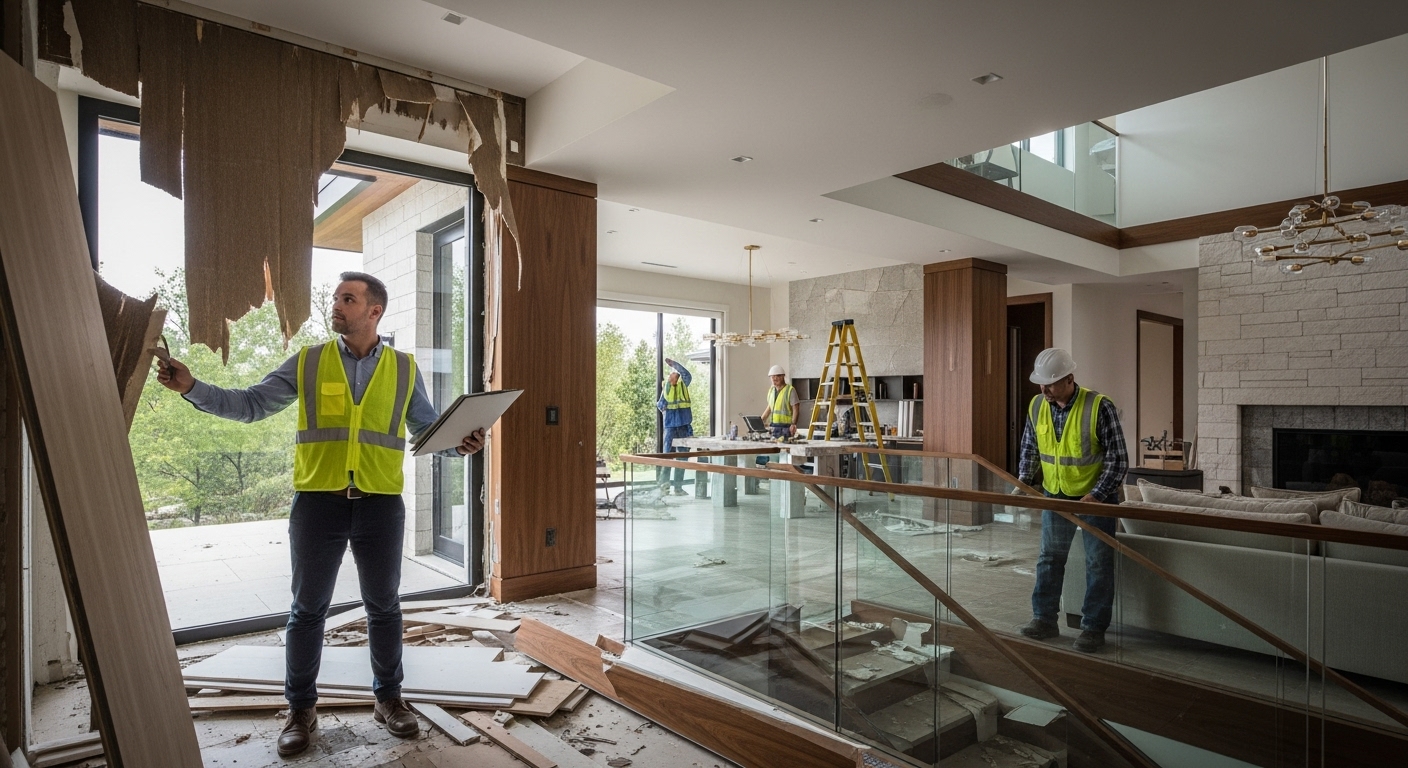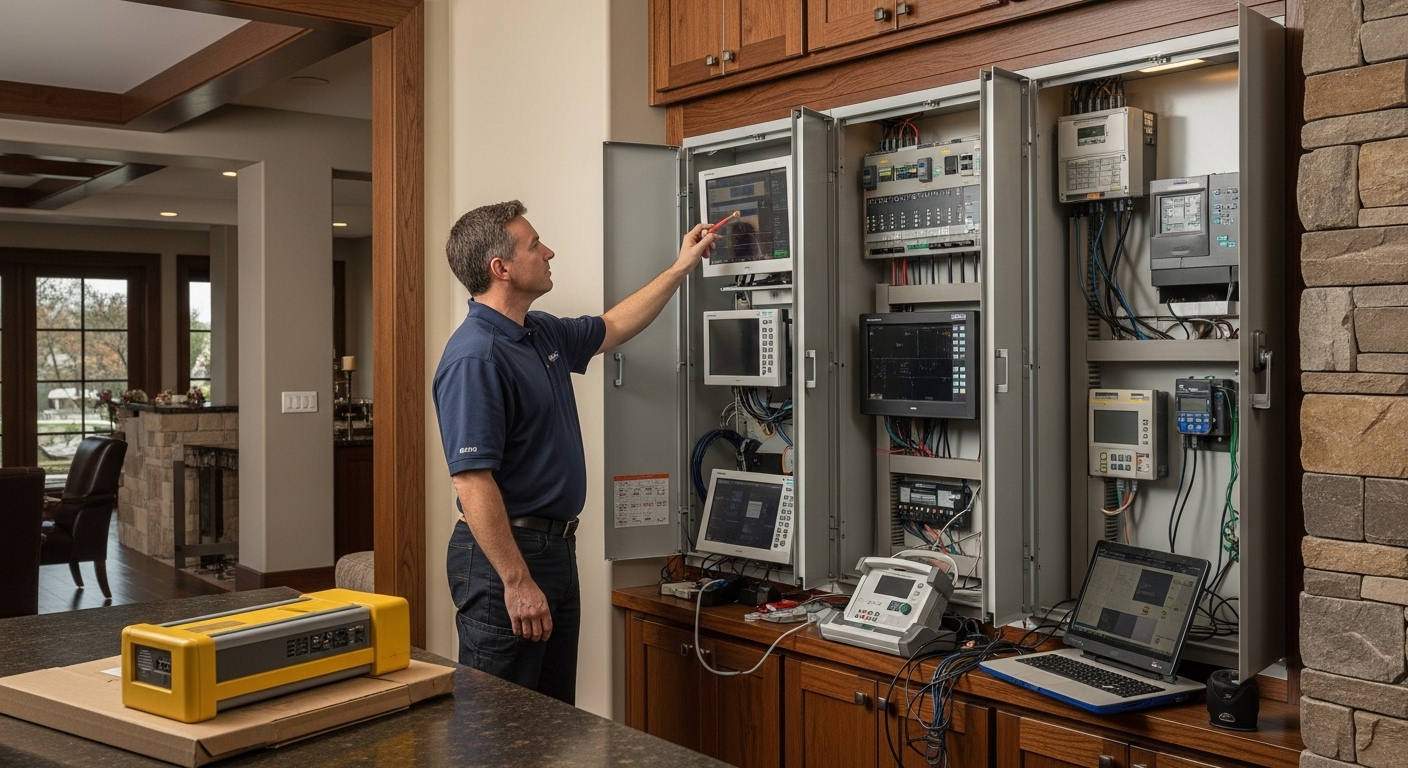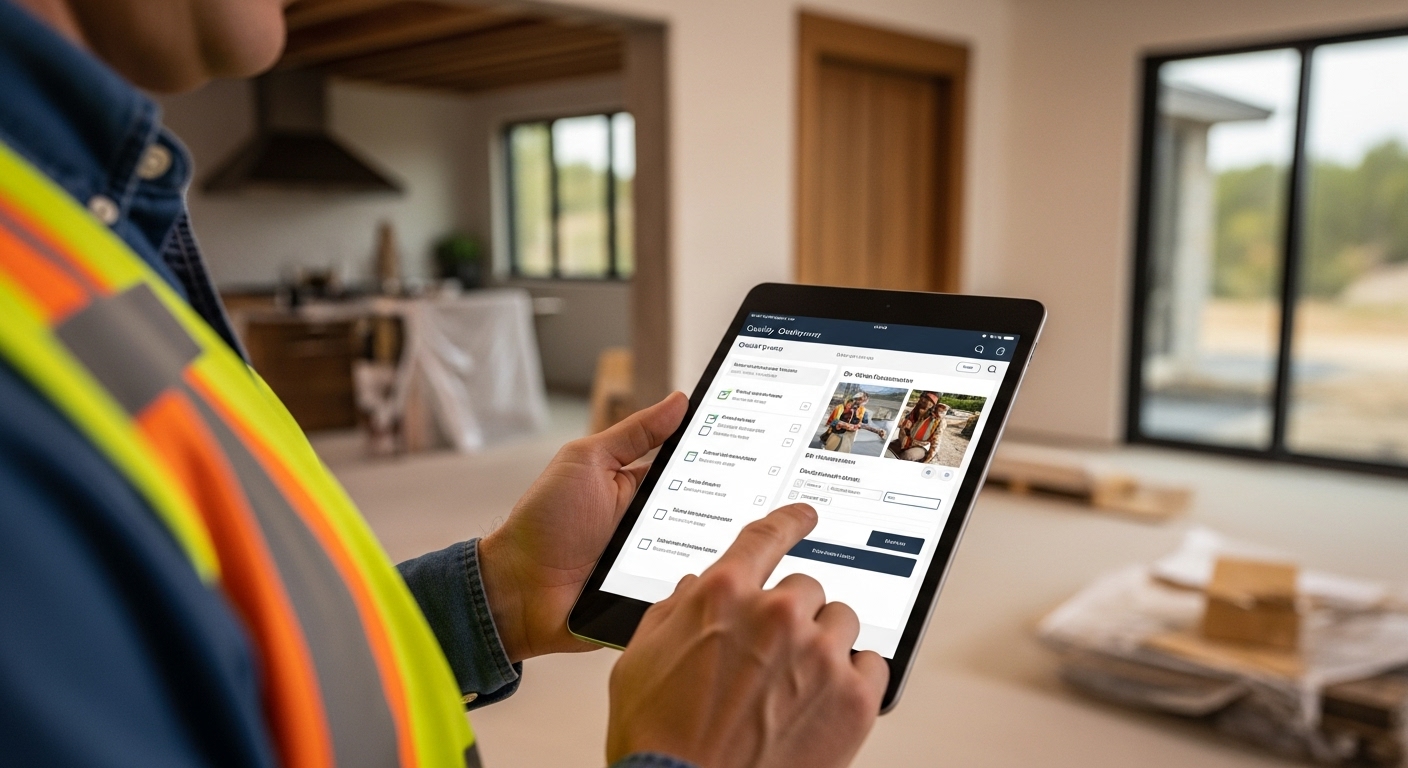August 9, 2025 by 100XBuilds Team
Quality Control Systems That Prevent Costly Rework

A single missed electrical rough-in inspection cost Meridian Custom Homes $47,000 in rework and delayed their $2.8M project by six weeks. That was the wake-up call that transformed their entire quality control approach—and increased their profit margins by 23% within 18 months.
Quality failures in luxury custom home construction don't just cost money—they destroy reputations, strain client relationships, and can sink entire projects. Yet most builders still rely on reactive quality control, catching problems after they've already become expensive disasters.
The data tells a stark story: builders with systematic quality control processes report 67% fewer change orders, 43% higher client satisfaction scores, and profit margins that average 3.2 percentage points higher than their reactive counterparts.
The True Cost of Quality Failures in Luxury Construction
When quality control fails in the luxury market, the financial impact cascades through every aspect of your business. Consider these real-world examples from builders who learned the hard way:
Structural rework: A misaligned foundation required complete demolition and rebuild, costing $180,000 and pushing delivery 4 months past deadline
Finish material failures: Incorrect stone installation throughout a 8,000 sq ft home required $95,000 in materials replacement and 6 weeks of additional labor
Systems integration issues: HVAC and smart home conflicts discovered during final walkthrough cost $32,000 to resolve and delayed closing by 3 weeks

The hidden costs extend beyond direct rework expenses:
Client relationship damage: 73% of clients who experience major quality issues reduce their referral likelihood by more than half
Team morale impact: Rework projects show 34% higher turnover rates among skilled craftsmen
Cash flow disruption: Quality failures delay milestone payments, creating working capital stress that can compound across multiple projects
Reputation risk: In the luxury market, word travels fast—one quality failure can impact your pipeline for 18+ months
Building Your Quality Prevention System
The most successful luxury builders don't just inspect quality—they engineer it into every process. This systematic approach requires three foundational elements:
Standardized Quality Checkpoints
Create mandatory hold points where work cannot proceed until quality standards are verified and documented. These checkpoints should align with your payment schedule and permit requirements:
Foundation stage: Elevation verification, rebar placement, utility rough-ins, and soil compaction testing
Framing completion: Structural integrity, dimensional accuracy, and rough-in coordination verification
Mechanical rough-in: System integration testing, code compliance verification, and performance baseline establishment
Finish installation: Material verification, installation standards compliance, and client approval documentation

Digital Documentation Systems
Paper-based quality control creates gaps, delays, and accountability issues. Digital systems provide real-time visibility and create permanent quality records:
Photo documentation requirements: Before, during, and after photos for every major installation, with timestamp and GPS verification
Deficiency tracking: Digital punch lists with assigned responsibility, target completion dates, and automatic follow-up reminders
Vendor accountability: Digital sign-offs from subcontractors acknowledging quality standards and completion verification
Client communication: Automated quality updates with photo documentation sent to clients at each checkpoint
Predictive Quality Metrics
Track leading indicators that predict quality issues before they become expensive problems:
First-time pass rates: Percentage of inspections passed without deficiencies by trade and project phase
Deficiency density: Number of quality issues per 1,000 square feet, tracked by trade and project type
Rework cost ratios: Rework expenses as percentage of original contract value, analyzed by cause and prevention opportunity
Vendor performance scores: Quality metrics by subcontractor, including deficiency rates, correction timeliness, and client feedback
Implementing Trade-Specific Quality Standards
Each trade requires tailored quality standards that address the most common and costly failure points in luxury construction:
Electrical Systems Integration
Luxury homes demand sophisticated electrical systems that must integrate seamlessly with smart home technology, security systems, and high-end appliances.
Pre-rough inspection requirements: Verify all low-voltage and high-voltage coordination, confirm smart home infrastructure placement, and validate load calculations
Rough-in verification: Test all circuits for proper grounding, verify AFCI/GFCI placement, and confirm panel labeling accuracy
Finish verification: Complete system testing with all integrated technologies, verify all outlet and switch functionality, and confirm client programming requirements

Plumbing System Performance
Water damage from plumbing failures can destroy entire luxury homes and create massive liability exposure.
Rough-in pressure testing: All supply lines tested at 150% working pressure for minimum 2 hours with zero pressure loss
Drain line verification: Camera inspection of all drain lines with documentation of proper slope and connection integrity
Fixture installation standards: Torque specifications for all connections, leak testing under full pressure, and flow rate verification
HVAC System Optimization
Luxury clients expect perfect climate control, and HVAC failures can trigger expensive warranty claims and client dissatisfaction.
Ductwork integrity testing: Pressure testing of all ductwork with maximum 5% leakage rate and proper insulation verification
Equipment commissioning: Full system balancing, refrigerant charge verification, and performance testing under design conditions
Indoor air quality verification: Testing for proper ventilation rates, filtration effectiveness, and humidity control performance
Technology Integration for Quality Control
Modern quality control systems leverage technology to eliminate human error and create comprehensive quality documentation:
Mobile Quality Management Platforms
Field teams need instant access to quality standards, documentation tools, and communication systems:
Offline capability: Quality checklists and documentation tools that work without internet connectivity
Photo integration: Automatic photo organization by trade, location, and quality checkpoint with GPS tagging
Real-time notifications: Instant alerts to project managers when quality issues are identified or resolved
Integration capabilities: Seamless connection with project management, accounting, and client communication systems

Automated Quality Reporting
Transform quality data into actionable insights that drive continuous improvement:
Weekly quality dashboards: Visual summaries of quality metrics by project, trade, and time period
Trend analysis: Identification of recurring quality issues and their root causes across multiple projects
Vendor performance tracking: Comparative analysis of subcontractor quality performance with objective scoring
Client satisfaction correlation: Analysis of quality metrics versus client satisfaction scores and referral rates
Training Your Team for Quality Excellence
Quality control systems only work when every team member understands their role and has the skills to execute consistently:
Superintendent Quality Training
Your superintendents are the front line of quality control and need specific skills and authority:
Quality standard enforcement: Clear authority to stop work when quality standards aren't met, with defined escalation procedures
Documentation requirements: Training on digital quality systems, photo documentation standards, and deficiency tracking
Vendor management: Skills for communicating quality expectations, managing corrective actions, and evaluating performance
Client communication: Protocols for quality-related client updates and issue resolution
Subcontractor Quality Integration
Your subcontractors must understand and commit to your quality standards:
Pre-project quality meetings: Review of specific quality requirements, documentation expectations, and accountability measures
Quality performance incentives: Financial incentives tied to first-time pass rates and deficiency-free completion
Ongoing quality feedback: Regular performance reviews with specific quality metrics and improvement recommendations
Quality partnership development: Long-term relationships with subcontractors who consistently meet quality standards

Measuring Quality Control ROI
Effective quality control systems generate measurable returns that justify their investment:
Direct Cost Savings
Track the financial impact of prevented quality failures:
Rework cost reduction: Compare rework expenses before and after quality system implementation
Schedule adherence improvement: Measure reduction in project delays caused by quality issues
Warranty claim reduction: Track decrease in post-completion quality-related expenses
Change order minimization: Monitor reduction in client-initiated changes due to quality concerns
Client Satisfaction Impact
Quality improvements directly correlate with client satisfaction and business growth:
Net Promoter Score improvement: Track client likelihood to recommend your services
Referral rate increases: Measure growth in client-generated leads and referrals
Repeat client percentage: Monitor rate of clients who hire you for additional projects
Online review quality: Track improvement in review ratings and quality-related comments
Competitive Advantage Metrics
Quality excellence creates sustainable competitive advantages:
Premium pricing capability: Ability to command higher margins due to quality reputation
Project pipeline strength: Increased qualified leads and shorter sales cycles
Vendor relationship quality: Access to top-tier subcontractors who want to work with quality-focused builders
Team retention improvement: Reduced turnover among skilled craftsmen who prefer quality-focused environments
Creating Your Quality Control Implementation Plan
Successful quality control implementation requires a systematic approach that builds capability while maintaining current project delivery:
Phase 1: Foundation Building (Months 1-3)
Quality standard documentation: Create detailed quality checklists for each trade and project phase
Digital system selection: Choose and implement quality management software that integrates with existing systems
Team training initiation: Begin training superintendents and key subcontractors on new quality requirements
Pilot project selection: Choose 1-2 current projects for initial quality system testing and refinement
Phase 2: System Expansion (Months 4-8)
Full team deployment: Expand quality training to all superintendents, project managers, and key subcontractors
Vendor integration: Implement quality requirements and performance tracking for all subcontractors
Client communication enhancement: Begin providing quality updates and documentation to clients
Metric tracking establishment: Implement comprehensive quality metrics tracking and reporting
Phase 3: Optimization and Growth (Months 9-12)
Performance analysis: Analyze quality metrics to identify improvement opportunities and best practices
System refinement: Optimize quality processes based on real-world experience and feedback
Competitive differentiation: Leverage quality excellence in marketing and sales presentations
Continuous improvement culture: Establish ongoing quality improvement processes and team recognition programs

Quality control isn't just about preventing problems—it's about creating a systematic competitive advantage that drives profitability, client satisfaction, and sustainable growth. Builders who implement comprehensive quality management systems don't just reduce rework costs; they transform their entire business model around excellence.
The luxury market demands perfection, and clients are willing to pay premium prices for builders who consistently deliver it. Your quality control system becomes your most powerful differentiator, creating a reputation that generates referrals, commands higher margins, and attracts the best craftsmen and clients.
Ready to transform your quality control approach and eliminate costly rework? Contact 100XBuilds today for a comprehensive quality management system assessment. We'll analyze your current processes, identify your biggest quality risks, and design a systematic approach that prevents problems before they become expensive disasters. Your clients—and your profit margins—will thank you.
